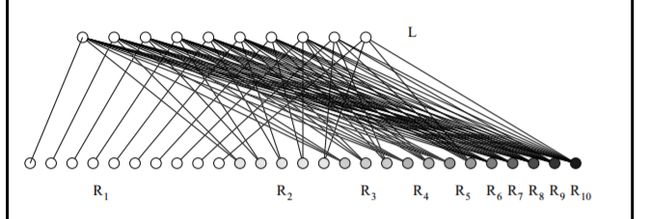hdu6150 构造题_ccpc
Vertex Cover
Time Limit: 2000/1000 MS (Java/Others) Memory Limit: 256000/256000 K (Java/Others)Total Submission(s): 524 Accepted Submission(s): 207
Special Judge
Problem Description
As we know,
minimumvertexcover is a classical NP-complete problem. There will not be polynomial time algorithm for it unless
P=NP.
You can see the definition of vertex cover in https://en.wikipedia.org/wiki/Vertex_cover.
Today, little M designs an "approximate" algorithm for vertex cover. It is a greedy algorithm. The main idea of her algorithm is that always choosing the maximum degree vertex into the solution set. The pseudo code of her algorithm is as follows:
We assume that the labels of the vertices are from 1 to n.
As a theory computer scientist, you immediately find that it is a bad algorithm. To show her that this algorithm dose not have a constant approximate factor, you need to construct an instance of vertex cover such that the solution get by this algorithm is much worse than the optimal solution.
Formally, your program need to output a simple undirected graph of at most 500 vertices. Moreover, you need to output a vertex cover solution of your graph. Your program will get Accept if and only if the solution size get by the above algorithm is at least three times as much as yours.
You can see the definition of vertex cover in https://en.wikipedia.org/wiki/Vertex_cover.
Today, little M designs an "approximate" algorithm for vertex cover. It is a greedy algorithm. The main idea of her algorithm is that always choosing the maximum degree vertex into the solution set. The pseudo code of her algorithm is as follows:
We assume that the labels of the vertices are from 1 to n.
for (int i = 1; i <= n; ++i) {
use[i] = false;
deg[i] = degree of the vertex i;
}
int ans = 0;
while (true) {
int mx = -1, u;
for (int i = 1; i <= n; ++i) {
if (use[i])
continue;
if (deg[i] >= mx) {
mx = deg[i];
u = i;
}
}
if (mx <= 0)
break;
++ans;
use[u] = true;
for (each vertex v adjacent to u)
--deg[v];
}
return ans;
As a theory computer scientist, you immediately find that it is a bad algorithm. To show her that this algorithm dose not have a constant approximate factor, you need to construct an instance of vertex cover such that the solution get by this algorithm is much worse than the optimal solution.
Formally, your program need to output a simple undirected graph of at most 500 vertices. Moreover, you need to output a vertex cover solution of your graph. Your program will get Accept if and only if the solution size get by the above algorithm is at least three times as much as yours.
Input
There is no input.
Output
First, output two integer
n and
m in a line, separated by a space, means the number of the vertices and the number of the edges in your graph.
In the next m lines, you should output two integers u and v for each line, separated by a space, which denotes an edge of your graph. It must be satisfied that 1≤u,v≤n and your graph is a simple undirected graph.
In the next line, output an integer k(1≤k≤n), means the size of your vertex cover solution.
Then output k lines, each line contains an integer u(1≤u≤n) which denotes the label of a vertex in your solution. It must be satisfied that your solution is a vertex cover of your graph.
In the next m lines, you should output two integers u and v for each line, separated by a space, which denotes an edge of your graph. It must be satisfied that 1≤u,v≤n and your graph is a simple undirected graph.
In the next line, output an integer k(1≤k≤n), means the size of your vertex cover solution.
Then output k lines, each line contains an integer u(1≤u≤n) which denotes the label of a vertex in your solution. It must be satisfied that your solution is a vertex cover of your graph.
Sample Output
4 4 1 2 2 3 3 4 4 1 2 1 3
Hint
The sample output is just to exemplify the output format.
Source
2017中国大学生程序设计竞赛 - 网络选拔赛
大概就是构造这么个图形,把左边的点分块(从一块分到n块)然后连接右边的点就行了。
#include
using namespace std;
const int maxn = 1000010;
pair edge[maxn];
int main(){
int l = 100, r = 100, tot = 0;
for (int i = 2; i <= l; i++){
for (int j = 0; j < l / i; j++){ //把左边分块 每次分块的大小是 l/i然后连接左右两边 即创建一个二分图 左边的点是n个 右边nlgn个
r++; //右边新增的每一个点需要连接i个块 如果i==100那么就要连100个点
for (int k = 1; k <= i; k++) edge[++tot] = make_pair(r, i * j + k);
}
}
printf("%d %d\n",r,tot);
for(int i=1;i<=tot;i++)printf("%d %d\n",edge[i].first,edge[i].second);
printf("%d\n",l);
for(int i=1;i<=l;i++)printf("%d\n",i);
return 0;
} 